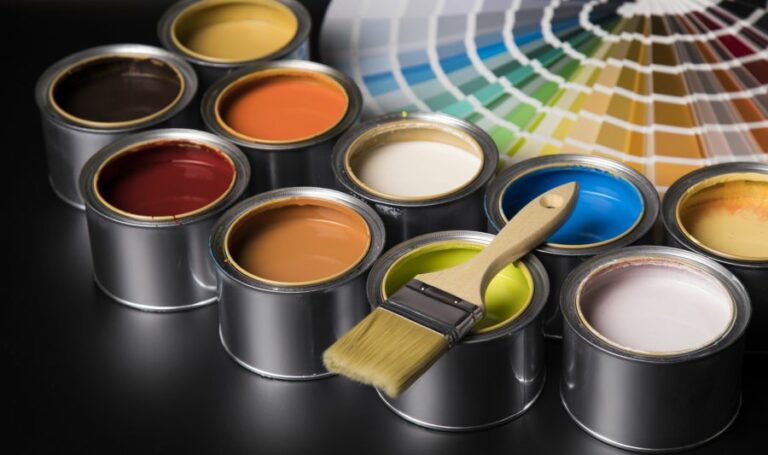Color Schemes For Indoor Paint, 25 Things You Should Know
When refreshing the look and feel of your home, choosing the perfect color scheme for indoor paint can make a world of difference. With countless shades and combinations available, nailing down the right palette might seem overwhelming. I have the tips and expertise to guide you in selecting a color scheme that reflects your personality and elevates your living space.
Color schemes for indoor paint:
Indoor paint color schemes comprise monochromatic, analogous, complementary, split-complementary, triadic, and tetradic combinations. These schemes utilize various shades, tints, and tones from the color wheel to create harmonious and unique spaces. Successful color selection depends on understanding color theory, the room’s purpose, lighting conditions, and maintaining balance in intensity and color placement.

Discover the perfect color schemes for your indoor paint projects! I’ll guide you through choosing the best combinations to transform your living spaces. Harmonize your interior design with a fresh, stylish look. Unleash your creativity and keep reading for our expert tips and exciting ideas!
Contents
- 1 Interior Paint Color Combinations Guide
- 2 Selecting the Perfect Interior Color Palette
- 3 Top 7 Color Scheme Ideas for Interior Design
- 4 Interior Paint Color Selection Principles
- 4.1 • Paint Color Basics: Understanding Color Theory
- 4.2 • The 60-30-10 Rule: A Timeless Rule for Interior Paint Colors
- 4.3 • The Importance of Undertones
- 4.4 • Light Matters: How Light Affects Paint Colors
- 4.5 • Supporting a Cohesive Look With Color Flow
- 4.6 • Personal Preferences: Trusting Your Instincts
- 4.7 • In Conclusion
- 5 Trending Interior Paint Colors in Demand
Interior Paint Color Combinations Guide
• Understanding Color Theory
Before diving into specific color schemes, it is essential to comprehend the basics of color theory. Color theory is a framework that artists and designers use to communicate with colors effectively.
Primary colors (red, blue, and yellow) combine to create secondary colors (orange, green, and purple), which then lead to the formation of tertiary colors.
A helpful resource to start with is the color wheel, an essential tool for selecting a harmonious color scheme. Familiarizing yourself with the color wheel is your first step towards creating beautiful, cohesive color schemes for your indoor spaces.
• Monochromatic Color Schemes
A monochromatic color scheme uses different shades, tints, and tones of a single color. This color scheme is one of the most straightforward to achieve and provides a cohesive, relaxing atmosphere. To create depth and contrast, pair lighter and darker shades of your chosen color together.
For example, using a palette of light blue for the walls and a deeper blue for furniture and accents creates a calming yet visually interesting space.
• Analogous Color Schemes
Analogous colors are those that sit next to each other on the color wheel. This color scheme uses the harmonious relationship between these colors to create a cohesive look. For instance, combining green, blue, and yellow can create a fresh, soothing atmosphere.
To achieve balance, try using one dominant color, a supporting color, and a third accent color. This approach ensures that the space does not feel overwhelming or chaotic.
• Complementary Color Schemes
Complementary colors are those that sit directly across from each other on the color wheel. This color scheme can create high-contrast, vibrant spaces when using bold, intense hues. Pairing together colors like red and green or purple and yellow can create a space that pops and feels energetic.
To achieve a more subdued look with complementary colors, opt for lighter or darker shades, or incorporate neutral tones for balance.
• Split-Complementary Color Schemes
A split-complementary color scheme is a variation of the complementary color scheme. Instead of using the direct opposite color on the wheel, it uses the two colors adjacent to the opposite color. This approach offers the visual contrast of a complementary color scheme without intensity.
For instance, pairing blue with red-orange and yellow-orange creates an invigorating space that feels balanced and not overly bold.
• Triadic Color Schemes
Triadic color schemes use three colors evenly spaced on the color wheel. This color scheme can create a balanced, harmonious space full of energy, provided attention is given to the intensity of the colors used.
For example, choosing primary colors (red, blue, and yellow) can create a dynamic, playful space. To achieve a more subdued look, opt for pastel shades or use one primary color and two secondary or tertiary colors.
• Tetradic Color Schemes
Tetradic (or double-complementary) color schemes use four colors composed of two complementary pairs. This color scheme offers an exceptionally rich palette and numerous possibilities. However, it can feel chaotic if proper balance and coordination aren’t maintained.
To create a tetradic color scheme, choose one dominant color, supported by the other three colors as accents. Carefully consider the intensity and placement of each color to create a harmonious atmosphere in your space.
• Recommendations for Successful Color Schemes
When it comes to selecting the perfect indoor paint color scheme, consider the following recommendations:
- Use a color wheel. Begin by familiarizing yourself with the color wheel, a fundamental tool for effective color selection.
- Consider the room’s purpose. Think about the desired atmosphere you want to create within the space. Choose colors that reflect that purpose and promote the desired mood.
- Pay attention to lighting. Color can appear differently under various types of lighting, both natural and artificial. Be sure to test your chosen paint colors in the room under different lighting conditions.
- Test your chosen colors. Before fully committing to a color, purchase a small sample of paint to apply on a portion of the wall. Observe how the color looks throughout the day and under different lighting conditions.
- Balance, balance, balance. Whether you choose a monochromatic, analogous, or tetradic color scheme, strive to achieve balance in intensity, saturation, and color placement. This approach can elevate your space into one of beauty and harmony.
With these principles in mind, it’s time to embark on your journey to create your ideal indoor paint color scheme. Armed with the knowledge of color theory and various color schemes, you now possess the tools necessary to create a space that reflects your unique taste and vision.
For even more in-depth information on color theory, visit the Exploratorium for a detailed guide. Happy painting!
Selecting the Perfect Interior Color Palette
An interior color scheme can make or break your home’s aesthetic appeal. A cohesive, well-thought-out palette sets the tone for the entire space, impacting mood and the overall visual appeal.
• Understanding Color Theory
Knowing the basics of color theory is essential in creating a harmonious color scheme. A basic understanding of how colors work together can help you determine the best color combinations for your space.
You can refer to the color wheel, divided into primary colors (red, blue, and yellow), secondary colors (orange, green, and purple), and tertiary colors (mixes between primary and secondary colors).
There are several color combinations based on the color wheel, such as:
- Monochromatic: Using different shades, tints, or tones of a single color to create a cohesive palette.
- Analogous: Combining colors that are next to each other on the color wheel.
- Complementary: Pairing colors opposite each other on the color wheel.
- Triadic: Using three evenly spaced colors on the color wheel.
More information on color theory and color combinations can be found in a reliable source, such as the Principles of Design by the University of Colorado.
• Determine Your Color Preferences
Start by evaluating your personal taste in colors. Consider your favorite hues, those that make you feel calm, energized, or inspired. Choosing colors that you enjoy will ensure you’re happy with the end results.
Browse through home design magazines, Pinterest, or design blogs to see what colors resonate with you. Save the images that appeal to you most, and you may find a pattern of preferred colors.
• Consider Your Home’s Existing Elements
Take note of your home’s architecture, furniture, and finishes. If you have an open floor plan, the colors should flow seamlessly from room to room, creating visual unity. Also, consider your existing furniture and other decor items.
If you don’t plan on changing these elements, be sure to choose a color scheme that complements them.
• Evaluate Light and Room Orientation
Assess the natural light in your space, as this will affect how colors appear. North-facing rooms get less direct sunlight, making them feel cool and shadowy. In these rooms, warm colors can help create a cozy atmosphere.
South-facing rooms receive more sunlight, making them ideal for cooler colors, which will strike a balance with the warmth of the sunlight.
• Test Potential Colors
Before committing to a specific shade or combination, test your chosen colors in your space. Purchase sample pots or paint large swatches on poster board and tape them to your walls. Observe the colors at different times of the day to see how they look in various lighting conditions.
This step is crucial as color may look different in-store due to different lighting or contrasting colors.
• Begin with a Neutral Base
A neutral base, such as white, beige, or gray, can serve as a foundation for your color scheme. Neutrals are versatile and timeless, ensuring that bold or saturated hues pair well with them. Choosing a neutral base allows you to experiment with more vibrant accent colors without overpowering the space.
Plus, if you find that you dislike the accent, changing it will be much easier than repainting the entire room.
• Add Color with Accents
Once your base color is chosen, add color through accent pieces, like decorative pillows, artwork, or an area rug. These items can significantly contribute to the overall color scheme, allowing you to change your palette relatively quickly if needed.
Start by choosing a dominant color, then add two or three complementary or contrasting colors for balance.
• Be Mindful of Color Psychology
Colors can evoke specific emotions and moods, so it’s essential to consider how you want your space to feel. For example, shades of blue and green are known to be calming and restful, making them ideal for bedrooms or bathrooms.
Warmer colors like red, orange, or yellow evoke energy, making them suitable for social spaces like living rooms and kitchens.
In conclusion, by understanding color theory, considering your personal preferences, assessing your space’s features, and testing potential colors, you can create a harmonious color scheme for your home.
Be sure to give thought to the overall atmosphere you wish to create, and don’t be afraid to experiment with different combinations or accent pieces.
Remember that choosing a color scheme is an opportunity to express your personal style, and ultimately, the palette that makes you feel most at home is the right choice.
Top 7 Color Scheme Ideas for Interior Design
Selecting an appropriate color scheme is a vital aspect of interior design, setting the tone and atmosphere within a space. The seven types of color schemes in interior design include complementary, split complementary, analogous, triadic, tetradic, monochromatic, and achromatic.
• 1. Complementary Color Scheme
A complementary color scheme utilizes colors that are opposite each other on the color wheel, such as blue and orange or red and green. This color scheme creates a dynamic and vibrant look that is ideal for spaces in need of an invigorating touch.
It is essential to balance the complementary colors, ensuring that they do not overpower each other. This can be achieved by using one dominant color and accentuating it with the complementary color. Read more on complementary color theory from Smashing Magazine.
• 2. Split Complementary Color Scheme
The split complementary color scheme involves choosing a base color and then selecting the two colors adjacent to its complement on the color wheel. For instance, if the base color is blue, the split complementary colors would be orange-yellow and orange-red.
This color scheme offers a harmonious blend of contrast and balance, providing a visually engaging yet soothing atmosphere in any interior design project. Split complementary schemes work well in both contemporary and traditional settings.
• 3. Analogous Color Scheme
An analogous color scheme comprises colors that are positioned next to each other on the color wheel, such as red, orange, and yellow, or blue, green, and violet. These color schemes create a harmonious and cohesive aesthetic, perfect for spaces where relaxation and serenity are desired.
To prevent an analogous color scheme from becoming monotonous, incorporate a variety of shades, tints, or tones of the chosen colors. Additionally, the introduction of some neutral colors, like white or grey, can provide balance and depth.
• 4. Triadic Color Scheme
A triadic color scheme uses three colors that are evenly spaced around the color wheel, such as red, blue, and yellow, or green, orange, and violet. This color scheme is characterized by a vibrant and energetic aesthetic, making it ideal for rooms that seek to evoke an uplifting and lively atmosphere.
To ensure visual balance, opt for one dominant color and use the other two colors for accents. The triadic color scheme benefits from the integration of various tones and shades to create depth and variety. Learn more about triadic color schemes from Color Matters.
• 5. Tetradic Color Scheme
The tetradic color scheme, also referred to as the double complementary scheme, involves selecting two sets of complementary colors from the color wheel. This can result in various combinations, such as orange and blue paired with red and green or yellow and violet paired with blue and orange.
This color scheme offers a diverse and complex palette for interior design projects. However, it may become overwhelming if not executed with care. Maintain visual balance by allowing one color to dominate while using the remaining colors as accents or to create contrast.
• 6. Monochromatic Color Scheme
A monochromatic color scheme is based on a single hue, which is then explored through various shades, tints, and tones. This color scheme offers a calming and unified aesthetic, making it a popular choice for bedrooms or other relaxing spaces.
To maintain visual interest within a monochromatic color scheme, incorporate different textures, patterns, or materials throughout the space.
Additionally, varying the application of the chosen color, for example, using lighter tones on the walls and darker tones in furniture, can create depth and visual appeal.
• 7. Achromatic Color Scheme
An achromatic color scheme consists solely of neutral colors, such as black, white, and grey. This color palette creates a sophisticated and timeless look, suitable for a wide range of interior design styles.
To prevent an achromatic scheme from appearing flat or uninspired, use a variety of shades ranging from light to dark, and introduce different textures and materials. The incorporation of patterns and graphic elements can also add visual intrigue to an achromatic color space.
In conclusion, understanding these seven color schemes can significantly enhance your interior design projects, aiding in the creation of dynamic and harmonious spaces that suit a variety of preferences and styles.
Selecting the appropriate color scheme helps set the tone within a space, evoking desired emotions and atmospheres.
Number | Color Scheme | Description |
|---|---|---|
1 | Monochromatic | A single color is used with various shades, tones, and tints to create depth and interest. |
2 | Complementary | Colors are chosen from opposite sides of the color wheel, creating a vibrant and dynamic contrast. |
3 | Analogous | Colors are chosen from adjacent sides on the color wheel, resulting in a harmonious and visually appealing space. |
4 | Triadic | Three colors evenly spaced around the color wheel are paired together for a bold yet balanced look. |
5 | Tetradic | Four colors arranged in two complementary pairs provide ample contrast and impact. |
6 | Split Complementary | One base color is paired with the two colors adjacent to its complementary color, offering a balance between contrast and harmony. |
7 | Neutral | A combination of neutral colors (black, white, gray, and beige) is used to create a calm, sophisticated, and versatile space. |
Interior Paint Color Selection Principles
Choosing the right paint color for your interior walls can be a daunting task but a crucial one. The right paint colors can help create a cohesive and harmonious atmosphere in your home and can even affect your mood and productivity.
• Paint Color Basics: Understanding Color Theory
Before delving into the rule for interior paint colors, it’s essential to have a basic understanding of color theory. Color theory is the science behind how colors interact, communicate, and evoke both particular visual and emotional responses.
One concept to understand is the color wheel, a visual representation of the relationships between primary, secondary, and tertiary colors. Familiarizing yourself with the color wheel will help you make well-informed decisions when selecting interior paint colors.
More information on color theory can be found on the National Gallery of Art website.
• The 60-30-10 Rule: A Timeless Rule for Interior Paint Colors
When it comes to the rule for interior paint colors, one timeless rule followed by many interior designers and decorators is the 60-30-10 rule. This rule helps to create balance and visual interest in a room by using a proportional distribution of colors. Below is a breakdown of the rule:
- 60% – Dominant Color: The dominant color, typically a neutral or subdued color, should cover approximately 60% of the room. It typically includes the walls, large furniture items, and flooring.
- 30% – Secondary Color: The secondary color should make up 30% of the room, adding contrast to the dominant color. This can include items like window treatments, smaller furniture pieces, and area rugs.
- 10% – Accent Color: The accent color should account for the remaining 10% of the room, providing a pop of color to create visual interest. Select items like decorative pillows, artwork, or accessories in the accent color.
Following the 60-30-10 rule can help you choose coordinating paint colors and accessories to create a balanced and visually appealing room.
• The Importance of Undertones
Color undertones play a significant role in paint color selection, and understanding them can help you achieve the desired effect in your space. Undertones can either be warm (yellow, red, or orange) or cool (blue, green, or violet).
Typically, colors with similar undertones work well together, creating a sense of harmony in the space. When selecting paint colors, be aware of the undertones and try to coordinate them throughout the space for the best results.
• Light Matters: How Light Affects Paint Colors
The way a paint color appears under different lighting conditions is a crucial factor to consider when selecting paint colors for your home interior. A color that looks fantastic under showroom lighting might appear less appealing in your space under natural light or artificial lighting.
Before making a final decision on paint colors, it is highly recommended to test the color by painting a small section of the wall in the intended space or on a sample board.
Observe how the color changes throughout the day under different lighting conditions to ensure you are satisfied with the colors in all light conditions.
• Supporting a Cohesive Look With Color Flow
When selecting paint colors for your home, it can be critical to consider color flow, the way colors transition from one room or space to another.
To maintain a sense of continuity and cohesion throughout your home, consider using various shades of the same hue or coordinating colors that flow well together.
This can be achieved by selecting a dominant color for the main living areas and using similar shades or coordinating colors for adjacent spaces.
• Personal Preferences: Trusting Your Instincts
While there may be certain rules and guidelines to follow for selecting interior paint colors, one of the essential factors to consider is your personal preferences. It’s your home, and it should reflect your personality and tastes.
While it’s helpful to follow guidelines, don’t be afraid to bend the rules, and make selections that resonate with you.
• In Conclusion
When selecting interior paint colors, it’s essential to blend art and science to find the perfect combination.
By understanding color theory, adhering to the 60-30-10 rule, considering undertones, and analyzing how light affects colors, you can make confident decisions in selecting the best paint colors for your home.
And most importantly, remember to trust your instincts and choose colors that make you happy and feel at home.
Trending Interior Paint Colors in Demand
• Classic Neutrals
Neutral colors create a calming atmosphere and can be paired easily with other colors. They are often considered timeless, making them a popular choice for many.
– Off-White
Off-white is a classic and versatile color that works well in any room. It creates a clean, harmonious look and complements any design style. According to Pantone, Off-White is recommended for its subtle elegance and charm.
– Gray
Gray is another popular neutral color that adds a modern touch while maintaining a sense of tranquility. It comes in various shades, allowing you to create dynamic contrasts and cohesive designs. Light gray tones provide a sophisticated and airy feel, while dark gray shades offer drama and depth.
– Beige
Beige tones – from light to dark – create a warm, inviting space with a hint of elegance. They can be easily combined with bolder colors for a striking effect or kept neutral for a minimalist look. Beige walls complement most furnishings and work well in living rooms, bedrooms, and entryways.
• Soft Pastels
Pastel colors can have a significant impact on the overall mood of a room, invoking feelings of relaxation, tranquility, and warmth.
– Pale Blue
Pale blue walls evoke a calm and serene atmosphere, often associated with coastal and beach-inspired interiors. This color works well in bedrooms and bathrooms, where relaxation is prioritized. Benjamin Moore offers a beautiful pale blue shade called Winter Ice that I recommend for its soothing qualities.
– Blush Pink
Blush pink is a soft, romantic color that adds warmth and sophistication to any interior. It works well in bedrooms, living rooms, and bathrooms, pairing beautifully with gold or brass accents. The historical association of pink with femininity has evolved, making it a versatile color choice for any room.
– Sage Green
Sage green is a muted, earthy color that brings a sense of tranquility and connection to nature indoors. It works exceptionally well in dining rooms and kitchens, establishing a soothing environment for gathering and dining. Pair it with white or wooden accents to create a balanced, harmonious space.
• Bold Hues
Bold colors can transform a space, making it feel more vibrant, energetic, and dynamic.
Navy blue walls exude sophistication and timeless elegance. This deep, rich color works well in dining rooms, offices, and even bedrooms, providing a cozy yet classic atmosphere.
Pair it with white or metallic accents to create a striking contrast, or opt for a monochromatic color scheme to achieve a trendy, modern look.
– Emerald Green
Emerald green offers a regal, luxurious feel to any room. This jewel tone can complement various interior design styles and works well with both modern and traditional furnishings.
Emerald green walls befit living rooms, dining rooms, and bedrooms, providing depth and character without overwhelming the space.
– Bold Yellow
Bold yellow walls can instantly brighten up a space, bringing a sense of energy and joy. This statement color can be used to create accent walls or enhance small, dimly lit rooms. Incorporate neutral furnishings and decor to balance the bold color and maintain a cohesive, stylish look.
• How to Choose the Right Paint Color
Selecting the ideal paint color for your space is a personal decision that can greatly impact the overall mood and aesthetic. Consider the following factors when making your choice:
- Evaluate the room’s purpose and the mood you want to evoke. Calming colors are best for bedrooms, while vibrant tones may work better in living spaces.
- Take into account your existing decor and furnishings. Choose a color that complements or contrasts with the elements you already have in the space.
- Examine the room’s size, natural light, and architecture. Lighter colors can help to create the illusion of a larger space, while darker shades can cozy up and add depth to a room.
- Order paint samples and test them in the space at different times of the day, as lighting can have a significant impact on the color’s appearance.
By considering these factors, you can confidently select the most fitting color for your indoor space and create a beautiful, inviting environment.







